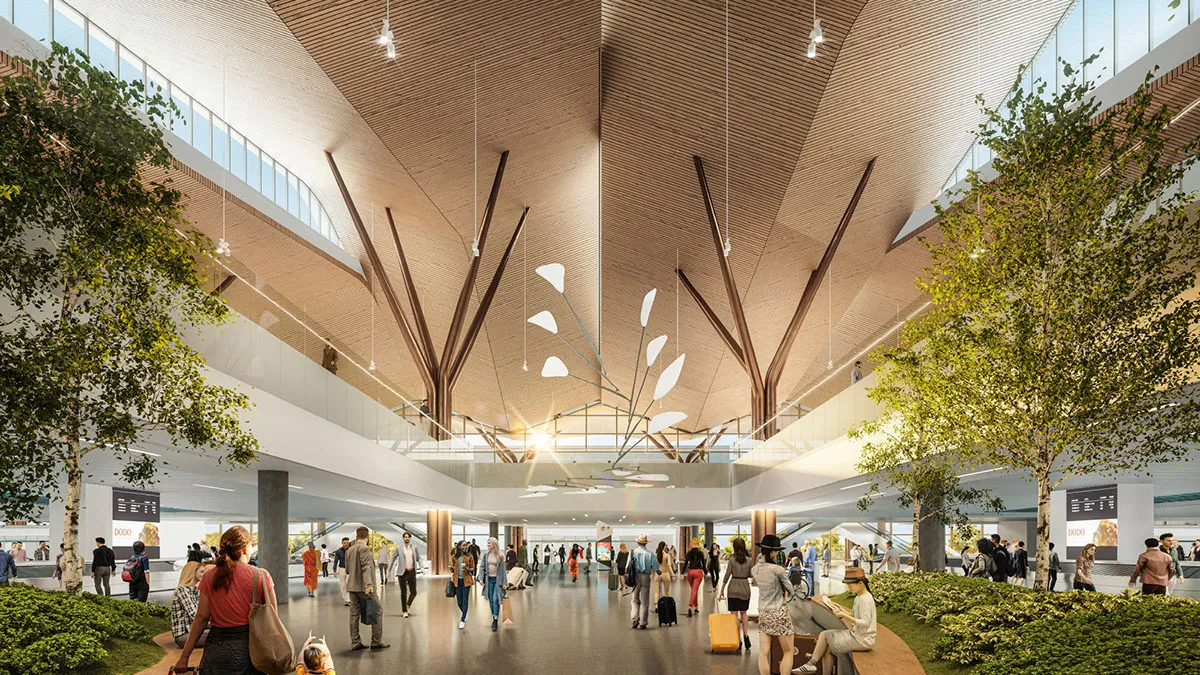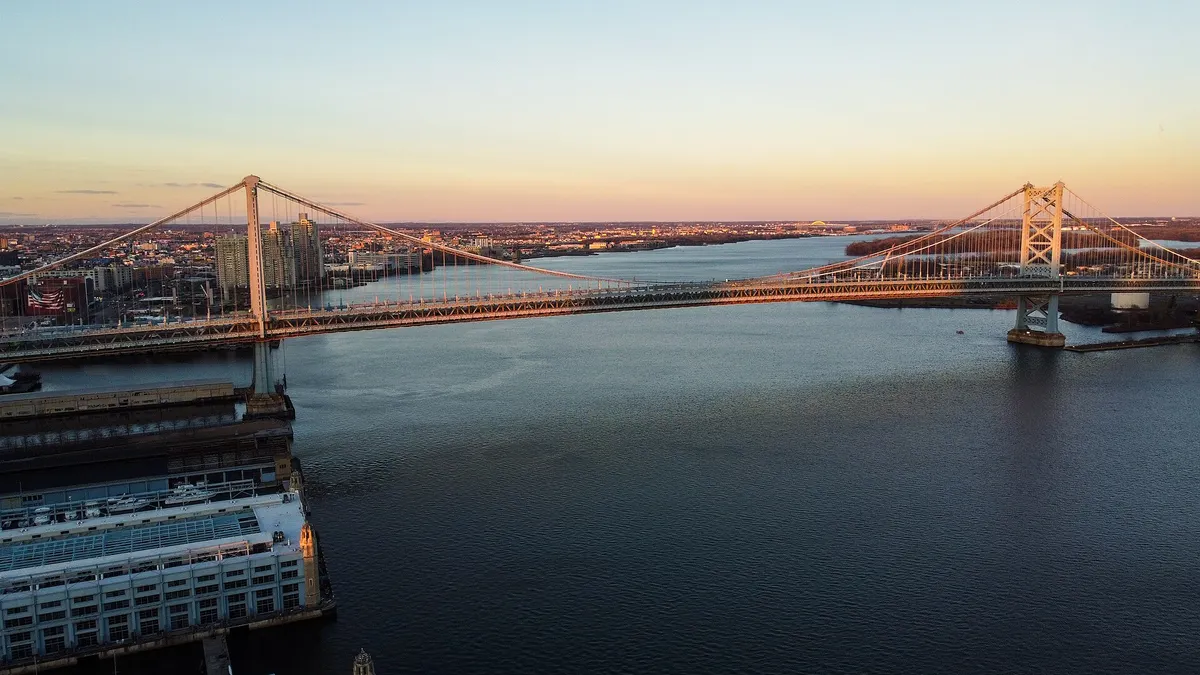As the COVID-19 pandemic moves toward its second full year in the U.S., airport construction projects that were placed on hold in its early months are mostly resuming, and some even accelerated during the period when passengers were away. Nonetheless, the pandemic has left its mark on air travel — including the physical infrastructure that enables it.
Going forward, experts say airports will prioritize touchless tech, adaptability and protecting public health, among other changes. Here are five trends in airport design and construction that builders need to know about:
1. Touchless interactions
Even before the pandemic began, airports and airlines had been moving to eliminate unnecessary contact between employees and travelers via remote check-in, self-print options for tickets and luggage tags and more, according to Bijan Vasigh, professor at Florida-based Embry-Riddle Aeronautical University. While this no-contact trend didn’t start with COVID-19, the pandemic has accelerated it, galvanizing terminal tech ranging from smart restrooms to robot workers.
Last year, American Airlines introduced touchless bag drops at Ronald Reagan Washington National Airport and across most terminals at Dallas/Fort Worth International Airport. Dubai International Airport recently installed the world’s first “smart tunnel,” which uses facial recognition to get travelers through passport control in 15 seconds without the need to stamp or touch anything, changing the way that security areas will be designed in the future. The U.S., Australia, and Norway were among the first countries to adopt this kind of biometric technology, and this model will likely continue to spread around the world.
Other aspects of the airport experience are changing, too. According to The Points Guy travel website, some airports have rolled out apps for travelers to order food without standing in line, or added touchless tech at check-in kiosks and feedback devices. Some airports are even testing out robots that bring customers their food at their seats, according to Joe Petrie, editorial director of Milwaukee-based Endeavor Aviation Group. The practice raises questions about how to allocate valuable concession space in designs of the future. The big takeaway: airports of the future will be flexible and high-tech.
"Automation is here, it’s going to keep growing, especially with the labor crisis that’s going on," said Petrie. "Airports and airlines are going to look at ways that they can automate different aspects, and how is that going to impact design? How might you have to rethink how a terminal is going to look if you go all-robot food delivery, or, say, [put] everything on a ramp, [so] instead of walking around refueling your plane it’s all robotically done?"
2. Adaptable terminals
In airports designed post-COVID, expect vacuous interiors and spaces that are designed with the ability to flexibly adapt to new uses, according to Travel and Leisure. “[Airports] have to be incredibly flexible with the space they have,” said Petrie. Having space that can be modified to new uses as needed helps complicated facilities like airports manage changes to how they normally work, such as new pandemic-related policies.
While it’s generally difficult to expand existing terminals, ones designed after 9/11 and especially post-pandemic have a larger footprint than past ones, according to Vasigh. In newly designed airports, there will likely be more emphasis on creating distance between travelers, and passengers will seek out green spaces and lounges with outdoor seating.
In addition, better ventilation to improve indoor air quality and to filter out viruses, germs and pollutants will also be vital. Terence Young, a principal and regional aviation leader at architecture firm Gensler, told Travel and Leisure that he believes airports might also adopt more "centralized clinics and health response teams that are ready to respond to biological toxins and infectious agents."
One place where some of these design elements can be seen is in the $1.4B Pittsburgh International Airport overhaul, which marks "the first new airport terminal designed and constructed in the post-pandemic world," according to the airport authority in charge of the project. Among the upgrades are new outdoor gardens between the terminals, as well as high ceilings and big windows.
3. A focus on business travelers
The airline industry is betting leisure travelers will be back in force as the pandemic wanes, but they expect business travel to take longer to recover. That’s difficult news for airlines, because while business travelers make up about 12% of airline passengers, they are twice as profitable as regular clients and bring in up to 75% of the profits, according to Investopedia. "The bread and butter of airlines are business travelers. They are paying top money, they are flying last-minute," Vasigh said. "But it will take some time for them to come back."
This trend has impacts for how and where development will occur near airports. One facility responding to this dynamic is Hartsfield-Jackson International Airport in Atlanta, Georgia, which is scaling back plans for a hotel and mixed-use development around its campus, in part due to the dropoff in business travelers. Hartsfield-Jackson didn’t stop building altogether though: France-based Worldwide Flight Services (WFS) has recently opened a high-tech air cargo terminal there to manage higher cargo traffic. The longer business travelers stay away, the more airports and airlines may rework amenities aimed at them.
One passenger air sector did grow during the pandemic: private flights. There was a spike in private jet usage and chartered flights as business flyers and others who could afford to ditched populated commercial planes, and the private jet industry saw its best month on record in October 2021, according to Fortune.
Chartered jets are seen as an economical option for groups that would typically fly business class, according to Petrie. These chartered flights are run by operators that rent private terminal facilities at commercial airports. Now these companies are thinking about how to appeal to these business people who make up their new and growing customer base.
4. An emphasis on cargo
As air travel plummeted during the pandemic, cargo was a financial lifeline for airlines. While passenger flights were bleeding money, demand for air cargo services reached record highs, according to Logistics Management, thanks to the growth of online shopping, which was supercharged during the pandemic.
Now more airports are adding cargo amenities as shipping companies like Amazon, UPS and FedEx demand more air cargo capacity. Experts expect this sector to continue to grow in all kinds of airports, from cargo-focused hub airports to passenger-focused airports of all sizes.
For example, Pittsburgh International Airport has developed several revenue streams, including cargo, air freight and mail shipping.
"It’s not always going to be the traditional players – it’s not going to be just the Miami’s or just the JFK’s or just the LAX’s – that are going to be these big, cargo-dominant places. You’re going to see it more too in some of these secondary-level airports," Petrie said. "People are not going to stop buying online anytime soon, it's just going to keep growing and growing."
Amenities needed to store and manage cargo include warehouses, temperature-controlled facilities and strong security infrastructure for sensitive goods like pharmaceuticals. These buildings are going high-tech, too. The new high-tech air cargo terminal at Hartsfield-Jackson in Atlanta can unload a plane in 30 minutes or less.
5. Increased public scrutiny
The aviation industry makes up 2.4% of global CO2 emissions, making it a top target for climate activists and other environmentally minded citizens, according to The Independent. Since the start of the pandemic, climate activists across the world have responded with no-fly pledges and airport project protests. This increased pushback is leading to some aviation projects to be scaled back or even shut down.
In February 2021, France scrapped plans to expand Charles de Gaulle Airport because it did not fit the country’s environmental goals. In November 2021, U.K. climate activists held the largest anti-airport protests in British history against expansion at 10 airports.
These are not isolated cases: Anti-airport protests have been growing worldwide over the past few decades, and some experts say they are likely to grow more frequent. In the U.S., there has been pushback to new airport projects in states including California, Connecticut, Florida, Illinois, Kentucky, New Mexico and Hawaii.
Some of the backlash is more targeted to the conditions of the community rather than broad climate concerns; the Chicago Rockford International Airport redesigned part of its 280-acre expansion project that was set to destroy a rare virgin prairie after locals protested.
The aviation industry is responding to these challenges, not only due to pressure but also because eco-friendly design is often good business sense too.
"Sustainability is becoming important [to the airline industry] when it comes to design, and it's not only 'is this good for the environment overall?,' because that’s a key part of sustainability, but also it comes down to 'can this save me money operationally?,'" said Petrie. "Sustainability [means] you're being sustainable with your resources, which means you should be spending less money overall, and that's a very appealing thing for all of these airport authorities."
In July 2021, Pittsburgh International became the first airport in the world to be powered by its own solar panel and natural gas microgrid. Petrie said airports in hot cities like Las Vegas are installing self-tinting glass that automatically adjusts to the light, resulting in a lower cooling bill (and the added benefit that comfortable customers also shop more.)
Other American airports are swapping diesel equipment for electric to clean the air. Petrie thinks that so long as airport authorities can demonstrate their commitment to sustainability and communicate honestly with their customers about their efforts, they likely won’t see pushback from local communities.
"Sustainability is not some hippie-dippie term that’s being thrown around that people don’t understand anymore. It has actual teeth. It has real-world consequences," Petrie said. "There are a lot of different ways airports can embrace it, and they are."























